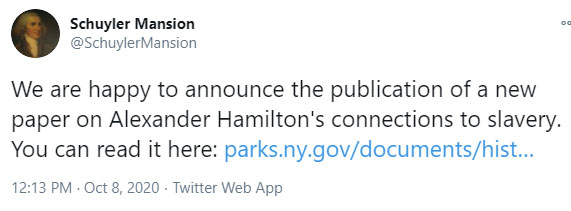© Posted on November 11, 2020, by Michael E. Newton.
On October 8, 2020, the Schuyler Mansion, home to American Revolution hero and U.S. Senator Philip Schuyler, who is probably best known as Alexander Hamilton’s father-in-law, released an essay entitled “As Odious and Immoral A Thing”: Alexander Hamilton’s Hidden History as an Enslaver.
The author of this essay asserts, “Not only did Alexander Hamilton enslave people, but his involvement in the institution of slavery was essential to his identity, both personally and professionally.”
An essay on such a narrow topic from a relatively minor historical site would normally not gather much attention, but then The New York Times on its website on November 9 and in the print edition on November 10 ran a story based on this essay entitled “Alexander Hamilton, Enslaver? New Research Says Yes,” repeating the claim that Hamilton “bought, sold and personally owned slaves.”
Unfortunately, the Schuyler Mansion essay is “riddled with errors, omissions, assumptions, speculations, and misrepresentations concerning the history of Alexander Hamilton on the subject of slavery.” The New York Times merely repeats these fallacies, adding just a few opinions from some notable historians and Hamilton biographers, comments which neither confirm nor refute the original claims.
After reading the original essay but long before the The New York Times story, Philo Hamilton decided to mount a response and solicited my assistance in doing so. The result is “Opening a Door to Their Emancipation”: Alexander Hamilton and Slavery, which points out the many factual errors in the Schuyler Mansion essay and refutes the many false claims and assertions. The essay also points out some, but certainly not all, of the work Hamilton did to help enslaved persons and free blacks and to end slavery in his home state.
Update, November 30, 2020: Philo Hamilton and I published version 2.0 of our essay, which should display below.
Some noteworthy changes in version 2.0 include:
- A greatly expanded discussion of Alexander Hamilton’s position on the Peace Treaty of 1783, the return of formerly enslaved persons, and the Jay Treaty.
- Improved explanations of how Hamilton used his cash books.
- More details about Hamilton’s involvement with the Manumission Society.
- New section about “servants and maids” and Eliza’s role in managing the household.
- Correction regarding Angelica Church’s 1804 letter to her son Philip.
Update, December 21, 2020: Version 3.0 of our essay is now available. Some noteworthy additions and improvements include:
- John B. Church’s purchase of an enslaved woman in 1783 has been greatly improved.
- New section on Alexander Hamilton as president of the New York Manumission Society.
- New research regarding the 1790 U.S. Census and Alexander Hamilton.
- New section about the “the black man of” Alexander Hamilton, who died in the yellow-fever epidemic of 1798.
Click to access Opening-a-Door-to-Their-Emancipation-Alexander-Hamilton-and-Slavery-3.0.pdf
The original essay (version 1.0) is still available here.
Version 2.0 is available here.


Thank you for submitting a rebuttal to the article released about Hamilton and his history with slavery. I am no Hamilton expert, nor have I done extensive research. But from the books I have read about Hamilton, it seems unlikely that he would support slavery. It is very possible that some of his actions were taken out of context and inferences were drawn. That is dangerous when not having proper context. I will be interested in reading your essay.
I have read your rebuttal and I was blown away by its details. Also, Hamilton’s cashbooks fascinates me. If Hamilton instead used a double entry system, things would have clearer and leas open to misinterpretation. I was really disappointed when the totals didn’t matched with the figures in the first article and was quite happy to read your explanation that have yielded the correct amounts. I also agree with your assumption that the asterisk is an X either because they were sold to pay for Hamilton’s debts already or it was error in the side of the executor.